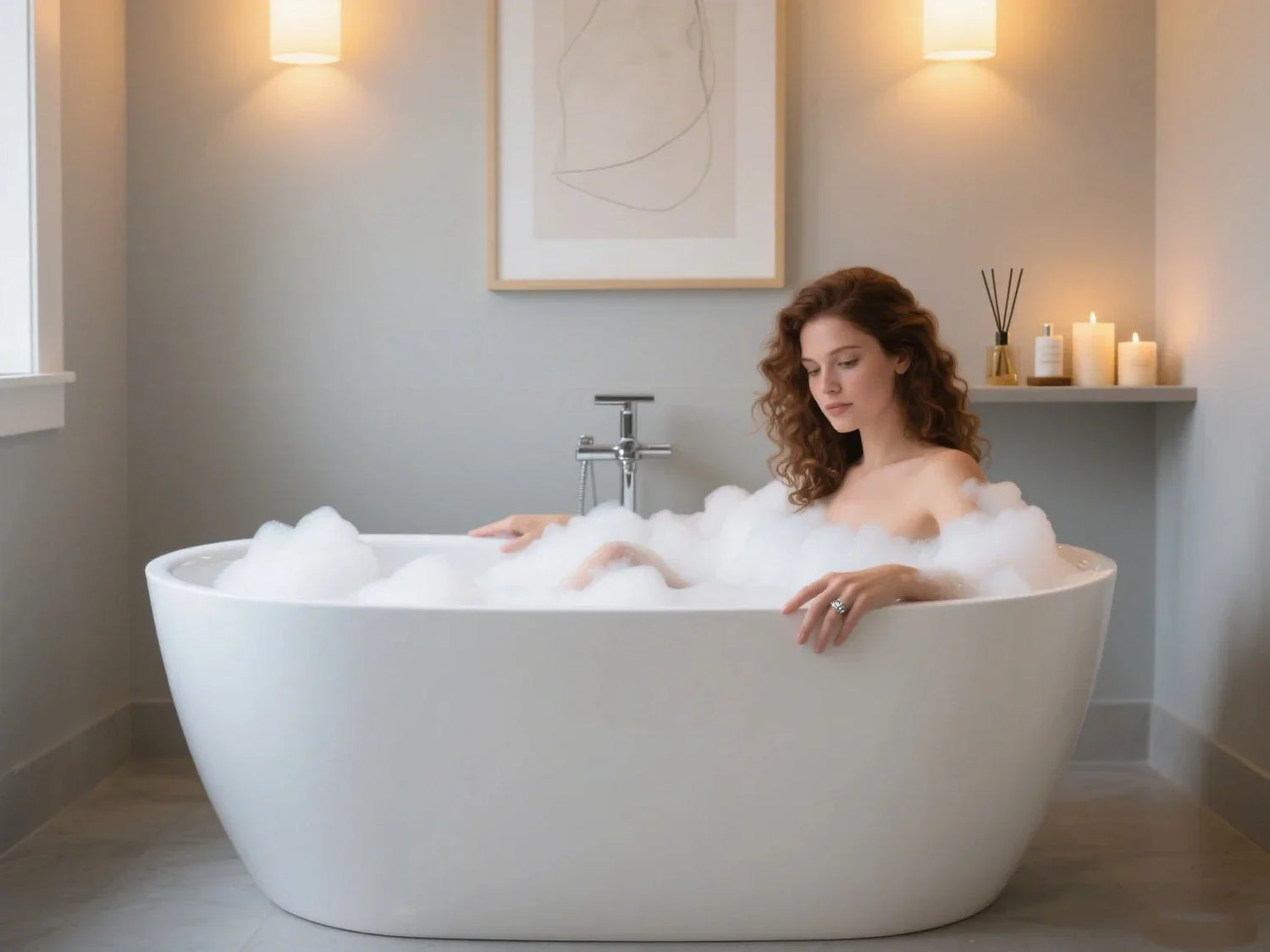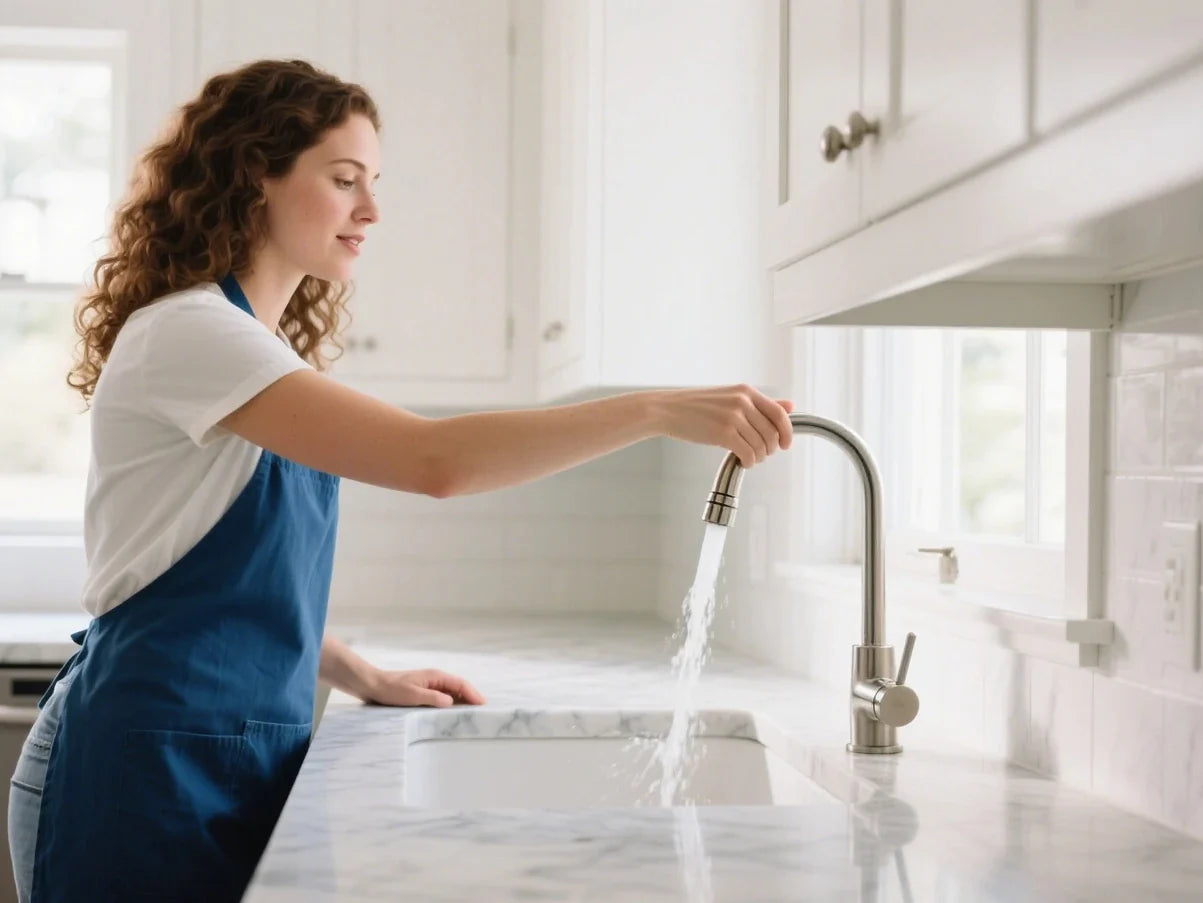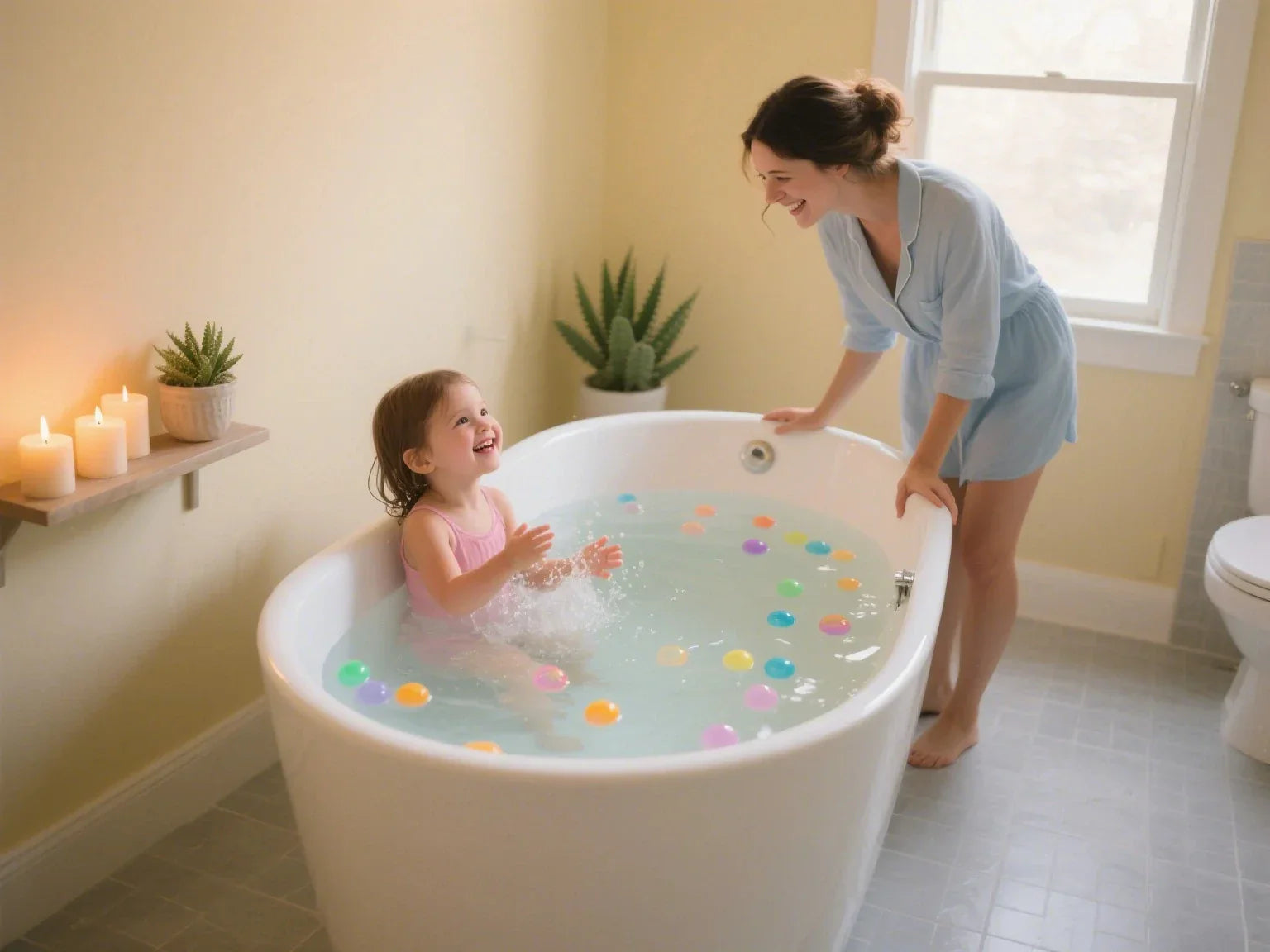Acrylic bathtubs have become the top choice for bathroom remodeling in 2025. Why? They offer the perfect mix of affordability, style, and comfort that homeowners want. Whether you're planning a complete bathroom remodel or just replacing an old tub, understanding acrylic bathtub options can save you money and headaches.
This guide breaks down everything you need to know about acrylic bathtubs. From material science to installation tips, we'll help you make the smart choice for your home. Ready to discover why millions of homeowners choose acrylic over other bathtub materials?
What Is an Acrylic Bathtub?
An acrylic bathtub is made from resin, a type of plastic reinforced with fiberglass, which gives it excellent strength and durability. This combination helps acrylic withstand daily wear and tear, making it a top choice for various home products like bathtubs. Acrylic is one of the most versatile materials available, known for its lightweight yet sturdy nature. The manufacturing process involves heating sheets of acrylic resin and shaping them, then reinforcing them with fiberglass backing to ensure rigidity and long-term performance.
Think of acrylic as the smart choice between expensive materials like cast iron and budget options like basic fiberglass.

Acrylic Bathtubs Pros and Cons
Pros of Acrylic Tubs
Are acrylic tubs good? Acrylic bathtubs offer several advantages that make them the material of choice for both homeowners and contractors:
Lightweight and Easy Installation
- Acrylic is much lighter than cast iron tubs or steel alternatives
- Easy to install compared to heavy materials
- Perfect for bathroom remodel projects in older homes
Heat Retention Properties
- Superior heat retention keeps your bath water warm longer
- Comfortable surface temperature - no cold shock when you step in
- Better than fiberglass tub options for thermal comfort
Design Flexibility
- Available in a variety of shapes and sizes
- Freestanding bathtub designs and built-in options
- Custom colors and finishes to match any style
Low Maintenance Requirements
- Non-porous surface resists mildew and bacteria growth
- Easy to clean with standard household products
- Acrylic bathtubs are very easy to maintain long-term
Cons of Acrylic Tubs
Every material has trade-offs. Here are the main cons of acrylic tubs:
- Surface can scratch with rough use or abrasive cleaners
- May chip or crack if heavy objects are dropped
- Quality varies - cheaper versions may yellow over time
The good news? Most damage is repairable with simple tub repair kits available at home improvement stores.
Acrylic vs. Fiberglass vs. Porcelain vs. Cast Iron: Which Material is Right for You?
When choosing a bathtub or sink, the material matters just as much as the design. Each option—acrylic bathtub, fiberglass bathtub, porcelain bathtub (enamel over steel), and cast iron bathtub—offers different strengths in terms of durability, weight, cost, maintenance, and overall feel. Here's how they compare:
Acrylic: Balanced and Modern
Acrylic material is a popular choice in modern bathrooms due to its lightweight construction, warm surface, and moderate cost. It’s durable, resistant to cracking, and retains heat fairly well, making it ideal for long, comfortable baths. The smooth, nonporous surface is easy to clean, and minor scratches can be repaired. Lifespan ranges from 10 to 15 years with proper care.
Best for: Homeowners seeking a stylish, comfortable, and low-maintenance option without breaking the bank.
Fiberglass: Budget-Friendly Starter Material
Fiberglass is one of the most affordable materials for tubs and showers, making it ideal for budget-conscious renovations or temporary upgrades. It’s extremely lightweight and easy to install, but it’s also the least durable. Over time, it may develop scratches, stains, or even cracks. Heat retention is poor, and repairs are difficult once damage occurs. Lifespan is typically 5–10 years.
Best for: Entry-level bathrooms, rental properties, or short-term remodeling.
Porcelain (Enamel over Steel): Classic and Affordable
Porcelain-coated steel offers a shiny, hard surface that looks classic and feels solid. It's heavier than acrylic or fiberglass but still lighter than cast iron. While easy to clean, the finish is prone to chipping, and once chipped, rust can develop underneath. Heat retention is moderate, and the surface can be slippery when wet. With care, it can last 10–15 years.
Best for: Traditional-style bathrooms or homeowners looking for a durable finish at a mid-range price point.
Cast Iron: Timeless and Ultra-Durable
Cast iron tubs and sinks are coated in a thick layer of enamel, offering unmatched durability, heat retention, and elegance. The material is extremely heavy, often requiring floor reinforcement and professional installation, but it can last over 50 years. The enamel surface is resistant to stains, scratches, and discoloration, though chips can be costly to repair.
Best for: Long-term homeowners, luxury bathrooms, or historic homes seeking a timeless look and premium quality.
Quick Comparison: Acrylic vs. Fiberglass vs. Porcelain vs. Cast Iron
| Feature | Acrylic | Fiberglass | Porcelain (on Steel) | Cast Iron (Enamel-Coated) |
|---|---|---|---|---|
| Durability | Good – flexible & crack-resistant | Fair – prone to scratches/cracks | Moderate – can chip, rust | Excellent – very strong & long-lasting |
| Weight | Lightweight | Very lightweight | Lightweight | Very heavy – may need reinforced floor |
| Heat Retention | Good | Poor | Fair | Excellent – retains heat very well |
| Finish | Glossy, warm feel | Dull or thin appearance | Smooth & shiny but hard | Smooth, luxurious, glass-like enamel |
| Ease of Cleaning | Easy – nonporous, smooth | Easy but porous – stains more easily | Easy – but needs care to avoid chipping | Very easy – highly stain-resistant |
| Cost | Moderate | Budget-friendly | Moderate | Expensive (material + installation) |
| Lifespan | 10–15 years | 5–10 years | 10–15 years | 50+ years |
| Common Uses | Tubs, sinks, showers | Entry-level tubs, showers | Affordable bathtubs, sinks | Luxury bathtubs, long-term fixtures |
| Repairability | Repairable (minor scratches) | Poor – cracks hard to repair | Chips hard to fix invisibly | Enamel chips can be repaired, but costly |

Acrylic Bathtub Market Overview 2025
The acrylic bathtub market is growing strong in 2025. Industry data shows the global market reaching $354 million with a steady 3.2% growth rate through 2033. What's driving this growth?
Market Trends:
- Bathroom remodel projects increasingly choose acrylic for versatility
- Home improvement focus on spa-like experiences
- Freestanding and whirlpool designs gaining popularity
- Commercial projects favor acrylic for cost-effectiveness
The overall bathtub market hits $8.8 billion in 2025, with acrylic bathtubs holding over 40% market share in residential applications. This dominance comes from the perfect balance of quality, affordability, and installation ease.
Top Acrylic Bathtub Brands of 2025
Choosing the right brand matters for long-term satisfaction. Here's what sets the best manufacturers apart:
Quality Indicators to Look For
Premium Acrylic Construction:
- Multiple layers of fiberglass reinforcement
- Consistent thickness throughout the tub
- Smooth, even surface finish
Design Innovation:
- Ergonomic shapes for comfort
- Whirlpool and air bath options
- Freestanding bathtub styles
Warranty Protection:
- 10+ year warranties on structure
- Surface finish guarantees
- Professional installation support
Brand Comparison Table
| Brand Category | Typical Models | Price Range | Key Features | Consumer Ratings |
| Premium Lines | Deep Soaking, Spa | $$$-$$$$ | Whirlpool and air, ergonomic design | 4.7/5 |
| Mid-Range Options | Standard, Alcove | $$-$$$ | Easy to install, antimicrobial coating | 4.5/5 |
| Luxury Freestanding | Designer, Custom | $$$$ | Modern finishes, oversized options | 4.8/5 |
How to Choose the Right Acrylic Bathtub
Measure Your Space First
Before falling in love with any bathtub, measure your bathroom carefully. Will you choose an alcove design, freestanding bathtub, or corner installation? Each style has different space requirements.
Standard Sizes:
- Small: 48-54 inches (perfect for guest baths)
- Standard: 60 inches (most common size)
- Large: 66-72 inches (luxury soaking experience)
Assess Build Quality
Not all acrylic bathtubs are created equal. Here's how to spot quality construction:
Check the Reinforcement:
- Look for reinforced fiberglass backing
- Feel for solid, rigid walls
- Avoid thin, flexible surfaces that may crack
Surface Quality:
- Smooth, consistent finish
- No visible air bubbles or imperfections
- Even color throughout
Style Trends in 2025
What's popular this year? These trends are shaping acrylic bathtub design:
Matte Finishes:
- Modern, spa-like appearance
- Hides water spots better than gloss
- Easy to maintain surface
Integrated Features:
- Built-in backrests and armrests
- Slip-resistant surfaces
- Whirlpool jets and air bubble systems
Custom Colors:
- Beyond basic white
- Earth tones and soft grays
- Matching bathroom décor
Key Features to Evaluate
Comfort Elements:
- Deep soaking depth (minimum 14 inches)
- Ergonomic shape for relaxation
- Smooth, warm-to-touch surface
Practical Considerations:
- Easy to clean surfaces
- Resistant to damage from normal use
- Compatible with standard plumbing

Installation Insights
Proper installation also plays a role in bathroom safety. The Consumer Product Safety Commission (CPSC) recommends secure fixture installation and moisture control to prevent slips, mold, and water damage in home bathrooms.
DIY vs. Professional Installation
Can you install an acrylic bathtub yourself? The lightweight nature of acrylic makes DIY installation possible for handy homeowners. However, consider these factors:
DIY-Friendly Scenarios:
- Replacing similar-sized alcove tub
- Good plumbing access
- Level subfloor
Professional Installation Recommended:
- Whirlpool and air bath systems
- Freestanding models requiring new plumbing
- Structural modifications needed
Typical Cost Breakdown
Acrylic bathtub installation costs less than heavy alternatives because:
Labor Savings:
- Lightweight material reduces installation time
- No floor reinforcement typically needed
- Easy to install with basic tools
Total Project Costs:
- Tub purchase: $300-$3,000
- Professional installation: $500-$1,500
- Plumbing adjustments: $200-$800
Common Installation Challenges
Subfloor Preparation:
- Must be perfectly level for proper support
- Acrylic shows any underlying imperfections
- Proper vapor barrier prevents moisture issues
Sealing and Support:
- Quality caulking prevents leaks
- Adequate support prevents flexing
- Proper drain connection essential
Maintenance & Durability
Acrylic bathtubs, made from resin plastic reinforced with fiberglass, are very easy to clean and maintain with the right approach. The durable properties of acrylic help resist mildew and bacteria buildup, and proper care protects against wear and tear, extending the life of your investment.
Routine Care for Your Acrylic Bathtub
According to the U.S. Department of Housing and Urban Development (HUD), proper bathroom maintenance helps reduce household health risks like mold and moisture damage. Acrylic bathtubs are very easy to maintain with the right approach. The non-porous surface naturally resists mildew and bacteria, but proper care extends the life of your investment.
Daily Cleaning:
- Rinse with warm water after each use
- Wipe dry to prevent water spots
- Use soft cloths only - no abrasive materials
Weekly Deep Cleaning:
- Mild dish soap and warm water work best
- Avoid harsh cleaning products with bleach or ammonia
- Non-abrasive bathroom cleaners are safe options

What to Avoid
Protecting your acrylic surface means avoiding certain products and practices:
Harmful Cleaning Products:
- Abrasive powders or scrubbers
- Products containing acetone
- Steel wool or rough sponges
Usage Precautions:
- Don't place extremely hot items directly on surface
- Avoid standing in tub with shoes
- Use bath mats to prevent scratch damage
Repair Guidance
Minor damage doesn't mean replacement. Since acrylic is repairable, most issues have simple solutions:
Surface Scratches:
- Fine scratches polish out with acrylic cleaner
- Deeper scratches need tub repair kits
- Professional refinishing for extensive damage
Small Chips or Cracks:
- DIY repair kits available at hardware stores
- Clean area thoroughly before applying filler
- Sand and polish for smooth finish
Longevity Expectations
How long will your acrylic bathtub last? With proper care, quality acrylic bathtubs can serve your family for many years to come:
- Premium acrylic installations: 15-25 years
- Standard quality: 10-15 years
- Budget options: 7-12 years
Factors Affecting Lifespan:
- Installation quality
- Usage patterns
- Maintenance consistency
- Initial material quality
Environmental Impact
Eco-Friendly Manufacturing
Modern acrylic production has become more environmentally conscious. According to the U.S. Environmental Protection Agency (EPA), using low-emission materials and improving indoor air quality are essential components of sustainable building materials. Leading manufacturers now use:
Sustainable Practices:
- Recycled content in acrylic formulations
- Reduced chemical emissions during production
- Energy-efficient manufacturing processes
End-of-Life Considerations:
- Acrylic can be recycled into new products
- Some manufacturers offer take-back programs
- Production waste often gets reprocessed
Green Building Benefits
Acrylic bathtubs contribute to sustainable building practices through:
- Lightweight transportation reduces carbon footprint
- Long lifespan means fewer replacements
- Easy to install reduces construction waste
Consumer & Expert Insights
Real User Experiences
What do homeowners actually think about their acrylic bathtubs? User feedback consistently highlights:
Top Satisfaction Factors:
- Warm, comfortable surface temperature
- Easy to maintain daily cleaning routine
- Attractive appearance that stays looking new
- Affordable luxury feeling
Common Concerns:
- Scratch susceptibility with rough use
- Color matching challenges when upgrading fixtures
- Quality differences between manufacturers
Professional Perspectives
Contractors and designers choose acrylic for practical reasons:
Installation Advantages:
- Lightweight material simplifies logistics
- Easy to install reduces labor costs
- Variety of shapes and sizes fits most projects
Long-term Benefits:
- Reliable performance over time
- Easy to clean reduces callback issues
- Good resale value of your home
Key Takeaways
Acrylic bathtubs represent the smart choice for modern homeowners in 2025. They combine affordability with performance, offering:
- Lightweight construction that's easy to install
- Excellent heat retention for comfortable bathing
- Non-porous surfaces that resist mildew and stay easy to clean
- Variety of shapes and sizes to fit any bathroom design
- Repairable surface that maintains appearance over time
Smart shopping tips:
- Choose reinforced with fiberglass construction
- Look for thick, rigid walls
- Consider an acrylic tub with good warranty coverage
- Factor installation costs into your budget
The bathtub material you choose affects your bathing experience for decades. Acrylic bathtubs deliver the comfort, style, and value that make them the popular material choice for home improvement projects.
Since acrylic technology continues advancing, 2025 models offer better durability and more design options than ever before. Whether you're planning a complete bathroom renovation or just replacing an old tub, acrylic deserves serious consideration for your new bathtub project.
This comprehensive guide helps you make an informed decision about acrylic bathtub options. The right choice depends on your specific needs, budget, and design preferences, but acrylic offers an excellent balance of features for most homeowners.
Frequently Asked Questions: Acrylic Bathtub
1. Are acrylic bathtubs any good?
The acrylic tub is really quite a good deal! It is lightweight, effortless to install, and holds heat well. The good quality acrylic material with reinforced fiberglass backing will last for years without problems. There are no pores on the surface, so it won't get moldy, and it's especially hassle-free to clean.
2. Which is better, an acrylic or ceramic bathtub?
Most homeowners favor acrylic bathtubs. Because it is comfortable, save money and good use of these points, pinch just right. Ceramic bathtub (refers to the kind of porcelain enamel, not steel) is indeed strong and durable, looking at the classic atmosphere, but there are many problems - heavy to death, touch cold, accidentally bumped and easily cracked. On the contrary, the acrylic bathtub, insulation effect pull full, bath water temperature can be maintained for a long time, comfortably soak for a while. And it is lightweight, installation is not difficult, do-it-yourself can handle. Modeling, color choices are super, the design also meets the ergonomics, lying down to take a bath don't mention how close. The price is also affordable, even if there are scratches after a long time, it is not complicated to repair. So in the long run, choose the acrylic bathtub is really cost-effective, the proper choice to save money.
3. What is the lifespan of an acrylic bathtub?
A good quality acrylic bathtub, if properly maintained, will generally last 15 to 25 years! However, the exact length of time depends on proper installation, usage and maintenance. Especially those who use high-quality reinforced fiberglass as the backing of the acrylic bathtub, more durable, can be used for 20 to 30 years without problems. It is definitely a durable bathtub!
4. Do acrylic tubs turn yellow over time?
A good quality acrylic bathtub is not prone to noticeable yellowing. This is because it is made with a good acrylic formula that can carry the damage of UV rays and chemicals. But the cheap acrylic bathtub is not the same, with a few years may be yellow, especially when encountering harsh detergents or bathroom ventilation is not good, more prone to discoloration. So don't try to choose a cheap bathtub, good material to stand the test of time!
5. Do acrylic tubs crack easily?
Acrylic bathtubs with proper reinforced fiberglass backing are quite resistant to damage. They're more flexible than porcelain, so they absorb impact better. Most cracks result from poor installation or extreme temperature changes. Quality installation and normal use prevent cracking.
6. Is fiberglass or acrylic better?
Acrylic bathtubs are so much better than regular fiberglass ones! It's more durable, holds heat better, and has a better surface texture. Although fiberglass bathtubs are cheaper to buy in the beginning, in the long run, acrylic bathtubs are more comfortable to use and last longer, which makes them more cost-effective. And acrylic if there is a scratch bump, repair than fiberglass is much more convenient!
References
- U.S. Environmental Protection Agency - Indoor Air Quality and Building Materials https://www.epa.gov/indoor-air-quality-iaq
- U.S. Department of Housing and Urban Development - Healthy Homes and Lead Hazard Control https://www.hud.gov/healthyhomes
- Consumer Product Safety Commission - Bathroom Safety Guidelines https://www.cpsc.gov/safety-education/safety-guides








Leave a comment
This site is protected by hCaptcha and the hCaptcha Privacy Policy and Terms of Service apply.